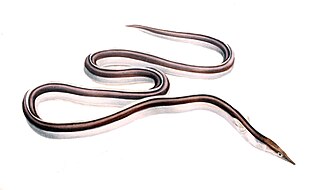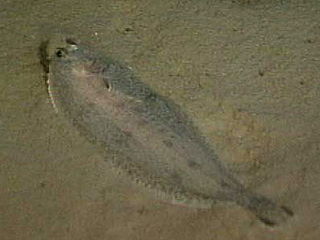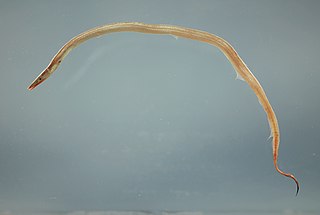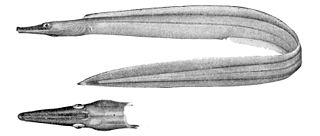
Pelagic fish live in the pelagic zone of ocean or lake waters—being neither close to the bottom nor near the shore—in contrast with demersal fish that live on or near the bottom, and reef fish that are associated with coral reefs.

Demersal fish, also known as groundfish, live and feed on or near the bottom of seas or lakes. They occupy the sea floors and lake beds, which usually consist of mud, sand, gravel or rocks. In coastal waters, they are found on or near the continental shelf, and in deep waters, they are found on or near the continental slope or along the continental rise. They are not generally found in the deepest waters, such as abyssal depths or on the abyssal plain, but they can be found around seamounts and islands. The word demersal comes from the Latin demergere, which means to sink.

The bramble shark is one of the two species of sharks in the family Echinorhinidae. Aside from the eastern Pacific Ocean, it is found in tropical and temperate waters worldwide. This rarely encountered shark swims close to the bottom of the seafloor, typically at depths of 400–900 m (1,300–3,000 ft), though it may enter much shallower water. The bramble shark has a stout body with two small dorsal fins positioned far back and no anal fin. It can be readily identified by the large, thorn-like dermal denticles scattered over its body, some of which may be fused together. It is purplish brown or black in color and grows up to 3.1 m (10 ft) long.

The serpent eel or sand snake-eel is an eel found in the eastern Atlantic Ocean, western Mediterranean Sea, western Indian Ocean, western Pacific Ocean and the north-east and west coast of North Island in New Zealand. It is an elongated, slender fish with a length of up to 250 centimetres. It spends the day with its body immersed in the sediment, emerging into the open water at night.

Nettastomatidae, the duckbill eels or witch eels are a family of eels. The name is from νῆττα and στόμα.

The Portuguese dogfish or Portuguese shark, is a species of sleeper shark of the family Somniosidae. This globally distributed species has been reported down to a depth of 3,675 m (12,057 ft), making it the deepest-living shark known. It inhabits lower continental slopes and abyssal plains, usually staying near the bottom. Stocky and dark brown in color, the Portuguese dogfish can be distinguished from similar-looking species by the small spines in front of its dorsal fins. Its dermal denticles are also unusual, resembling the scales of a bony fish. This species typically reaches 0.9–1 m (3.0–3.3 ft) in length; sharks in the Mediterranean Sea are much smaller and have distinct depth and food preferences.

The blackmouth catshark is a species of deepwater catshark, belonging yo the family Pentanchidae, common in the northeastern Atlantic Ocean from Iceland to Senegal, including the Mediterranean Sea. It is typically found over the continental slope at depths of 150–1,400 m (490–4,590 ft), on or near muddy bottoms. The youngest sharks generally inhabit shallower water than the older juveniles and adults. This slim-bodied species is characterized by the black interior of its mouth, a marbled pattern of pale-edged brownish saddles or blotches along its back and tail, and a prominent saw-toothed crest of enlarged dermal denticles along the upper edge of its caudal fin. It reaches lengths of 50–79 cm (20–31 in), with sharks in the Atlantic growing larger than those in the Mediterranean.

The Atlantic sawtail catshark is a little-known species of deepwater catshark, belonging to the family Pentanchidae, found in a small area of the northeastern Atlantic Ocean, centered on the Strait of Gibraltar and the Alborán Sea. It is found on or close to the bottom over the continental slope, mostly at depths of 400–600 m (1,300–2,000 ft). This shark closely resembles, and was once thought to be the same species as, the blackmouth catshark (G. melastomus); both are slender with a series of dark saddles and blotches along the back and tail, and a prominent crest of enlarged dermal denticles along the dorsal edge of the caudal fin. It differs subtly from G. melastomus in characters including snout length, caudal peduncle depth, and the color of the furrows at the corner of its mouth.

The witch, known in English by a variety of other common names including the witch flounder, pole flounder, craig fluke, Torbay sole, and grey sole, is a species of flatfish from the family Pleuronectidae. It occurs on both sides of the North Atlantic Ocean on muddy sea beds in quite deep water. In northern Europe it has some importance in fisheries as a food fish.
The great sand eel is the greater species of sand eel. The maximum size is 35 centimetres (14 in).

The black goby is a species of ray-finned fish found in the Eastern Atlantic and Mediterranean Sea and Black Sea. It inhabits estuaries, lagoons, and inshore water over seagrass and algae. It feeds on a variety of invertebrates and sometimes small fish. This species can also be found in the aquarium trade.

Chimaera monstrosa, also known as the rabbit fish or rat fish, is a northeast Atlantic and Mediterranean species of cartilaginous fish in the family Chimaeridae. The rabbit fish is known for its characteristically large head and small, tapering body. With large eyes, nostrils, and tooth plates, the head gives them a rabbit-like appearance, hence the nickname "Rabbit fish". They can grow to 1.5 metres (5 ft) and live for up to 30 years.

Coastal fish, also called inshore fish or neritic fish, inhabit the sea between the shoreline and the edge of the continental shelf. Since the continental shelf is usually less than 200 metres (660 ft) deep, it follows that pelagic coastal fish are generally epipelagic fish, inhabiting the sunlit epipelagic zone. Coastal fish can be contrasted with oceanic fish or offshore fish, which inhabit the deep seas beyond the continental shelves.

Nettastoma is a genus of eels in the duckbill eel family Nettastomatidae.

Tripterygion melanurum is a species of fish in the family Tripterygiidae, the threefin blennies. It is widespread in the Mediterranean Sea, where it occurs around the Balearic Islands and off the coasts of southern Sardinia, Algeria, Tunisia, Israel, Lebanon, Greece, Cyprus, and southern Turkey. It is a marine subtropical demersal fish measuring up to 5.3 centimetres (2.1 in) in length.

The freckled pike-conger, also known as the silver conger, is an eel in the family Nettastomatidae. It was described by Isaac Ginsburg in 1951. It is a marine, subtropical eel which is known from the western central Atlantic Ocean, including the Gulf of Mexico, Colombia, and towards the mouth of the Amazon River. It dwells at a depth range of 55–310 meters. Males can reach a maximum total length of 54.2 centimeters.

The duck-billed eel, also known as the shortsnouted sorcerer or the smallhead duckbill eel, is an eel in the family Nettastomatidae. It was described by Albert Günther in 1877. It is a marine, deep water-dwelling eel, which is known from the Indo-Pacific and the southeastern Pacific Ocean, including Japan, Hawaii, eastern Australia, southeastern Africa, and Chile. It dwells at a depth range of 60–1190 metres, and inhabits the continental shelf and slope. Males can reach a maximum total length of 83 centimetres.
The whipsnout sorcerer is an eel in the family Nettastomatidae. It was described by Léon Vaillant in 1888, originally under the genus Nettastoma. It is a marine, deep water-dwelling eel which is known from tropical, subtropical and temperate areas throughout the world. It dwells at a depth range of 385 to 2,200 metres, and inhabits the lower region of the continental slope. Males can reach a maximum total length of 100 centimetres (39 in).

Dysommina rugosa is an eel in the family Synaphobranchidae. It was described by Isaac Ginsburg in 1951. It is a marine, deep water-dwelling eel which is known from the western Atlantic and eastern central Pacific Ocean. It dwells at a depth range of 260–775 metres, and is found off the continental slope. Males can reach a maximum total length of 37 centimetres.
Gurgesiella atlantica, commonly known as the Atlantic pygmy skate, Atlantic finless skate, or simply the Atlantic skate, is a skate species in the family Gurgesiellidae. It lives in the western central and southwest Atlantic Ocean, from Nicaragua to Brazil. It grows to 49 centimetres (19 in) – 52 centimetres (20 in) long and is distinguished from other skates by its long, slender tail and absence of dorsal fins.


















